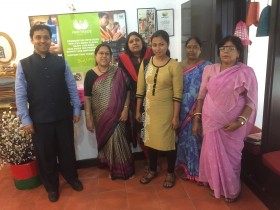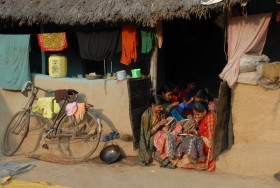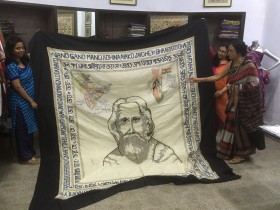SAI’s Livelihood Creation project is underway on the ground in India. The research project, supported by the Tata Trusts, aims to build knowledge and capacity around three key areas: rural livelihood creation (emphasis on the handicrafts and handloom sectors); educational, social and economic empowerment of women; and science and technology-based interventions for poverty alleviation.
By Shashank Shah, Project Director
The journey of the SAI Team to the East Indian states culminated in Kolkata, the capital city of West Bengal. Capital of India until 1911, Kolkata was the most populous city in India till the mid-1980s when Bombay (now Mumbai) overtook it. For many centuries, West Bengal and its geographic headquarters has been a leader in art and culture, music and literature, education and religious renaissance. Started in 1857, the University of Calcutta is among the oldest in British India.
The city is also host to top academic institutions including the Indian Institute of Management at Joka and the Indian Statistical Institute. From Swami Vivekananda to Sri Aurobindo, from Raja Ram Mohan Roy to Subhas Chandra Bose, from Rabindranath Tagore to Bankim Chandra Chatterjee, Kolkata has witnessed the inspiration of many a great individuals who contributed immensely to the welfare of the society through diverse fields.
Popularly called the City of Joy (also a book by that name authored by Dominique Lapierre), our team witnessed a number of ‘Joys’ (actually ‘Jais’), meaning victory to the Mother Goddess, as we were in Kolkata during one of the most popular festivals – Kali Puja (the other being Durga Puja). Huge pandals with idols of Goddess Kali across the city, and lights and festivity all over made the visit even more memorable. In the midst of this celebration and gaiety, we had the opportunity to visit 5 organizations that have been proactively working towards the empowerment of the crafts sector for many decades.
The first visit was to the Self Help Enterprise (SHE). A long and lively discussion with Shamlu Dudeja, the Founder, revealed her passion and commitment towards the betterment of the Kantha artisans in rural West Bengal. A former professor of Mathematics, Shamlu founded the organization around 1990. Since then, it has continuously attempted to bring a feeling of dignity and self-sufficiency for over 10,000 rural women associated with it. For those who don’t know, Kantha is a form of embroidery based on running stitch which is known to have been practiced by cavemen and Buddhist monks. This work has been practised by the rural women of West Bengal for a long time. The art almost died during the British period. It was Tagore’s family that started it again in some form. Shamlu’s work has brought recognition for the organization and the art form from various quarters. M.K. Narayanan, Governor of West Bengal (2009-2014), recognized SHE’s contribution and efforts and felicitated many of its artisans at the Raj Bhavan (Governor’s Bungalow) in a special function. Senator Hillary Rodham Clinton visited the SHE stall in one of the international exhibitions and purchased an art piece with the image of Tagore, which she eventually gifted to the Chief Minister of West Bengal – Mamta Bannerjee. The last quarter century has been a journey of satisfaction for Shamlu and her small team.
 The next destination was the Sasha Association for Craft Producers. The interview with Sujata Goswami, Executive Director of SSA (Sarba Shanti Ayog, the organization that focusses on rural empowerment and capacity building) provided an overview to the work of the sister organizations – SSA and Sasha (the commercial counterpart). Founded in 1978, Sasha does most of its work in Southern West Bengal. However, it also has a geographical presence in Coastal Odisha, Eastern Uttar Pradesh, Telangana, Gujarat and Kashmir. Around 85 percent of its revenues are from exports, with the bulk of the demand coming from Western European countries. Over 10,000 rural artisans have benefitted from association with Sasha. Their craft work mainly covers products including home accessories, home textiles, personal accessories, apparel, children’s and wellness products. With a strong desire to expand their reach – within the rural hinterland to cover more artisans, and with the international customers to make their products available in distant lands, Sasha is very active across social media platforms including Facebook and Twitter. It is also member of the World Fair Trade Organization, and runs on the Fair Trade Principles.
The next destination was the Sasha Association for Craft Producers. The interview with Sujata Goswami, Executive Director of SSA (Sarba Shanti Ayog, the organization that focusses on rural empowerment and capacity building) provided an overview to the work of the sister organizations – SSA and Sasha (the commercial counterpart). Founded in 1978, Sasha does most of its work in Southern West Bengal. However, it also has a geographical presence in Coastal Odisha, Eastern Uttar Pradesh, Telangana, Gujarat and Kashmir. Around 85 percent of its revenues are from exports, with the bulk of the demand coming from Western European countries. Over 10,000 rural artisans have benefitted from association with Sasha. Their craft work mainly covers products including home accessories, home textiles, personal accessories, apparel, children’s and wellness products. With a strong desire to expand their reach – within the rural hinterland to cover more artisans, and with the international customers to make their products available in distant lands, Sasha is very active across social media platforms including Facebook and Twitter. It is also member of the World Fair Trade Organization, and runs on the Fair Trade Principles.
The last visit for the day was at the Madhya Kalikata Shilpangan in Mukundapur. Mithu Dam founded the organization in 1994. The NGO has now transitioned into a commercial enterprise with operations in West Bengal and Odisha. Due to increasing international demand, leather work is the predominant craft form it is involved in, and exports constitute 100 percent of their sales. The main export markets are Italy, Germany, U.K., Belgium, Netherlands and Australia. With plans of expansion, it currently has its own manufacturing unit, and the permanent employees with the leather unit earn around INR 7,000 rupees per month. Prior to their association with the organization, they earned nothing.
The visits on the second day began with Kadam. Payal Nath, founder of the organization and a former Consultant with the Government of India founded Kadam in 2006 along with her sister Pooja Ratnakar, who is based out of Delhi. Kadam has a unique model of investing time with the artisans in the rural areas of capacity building and training. After a few years, when the cluster is sufficiently empowered to deliver end-to-end outputs, Kadam weans them out of their direct support. However, it is available for any guidance for many years post their active association. Reputed corporations actively support Kadam. The organization also has partnerships with reputed academic institutions like the Indian Institute of Technology at Kharagpur, the National Institute of Design, the National Institute of Fashion Technology, and the Indian Institute of Crafts and Design. In the last decade, over 600 families have been benefited by association with Kadam. The bamboo clusters that Kadam has worked in saw the monthly household income of the rural craftspeople increase from INR 1,000 to INR 20,000. Given that our team’s discussion with Payal was in the retail outlet of Kadam in the Salt Lake area, we ‘indulged’ in shopping for our team back in Boston!
Our Kolkata visits culminated with a visit to AIM (Art Illuminates Mankind). An interaction in Hindi with Rimi Roy and her team was a different experience. The organization was founded in the year 2003, and is predominantly working with the capacity building grants from the Government of West Bengal for rural artisans. AIM gives comprehensive training to women with focus on art forms like Kantha, Batik printing, and bamboo products. An innovative practice AIM follows is the use of organic cotton and organic colors in its products. In the last dozen years, over 6,000 people benefitted in their association with AIM, with 90 percent of the beneficiaries being women. Like most of the other organizations, AIM is also affiliated with the Fair Trade India Forum and follows the Fair Trade Principles.
With this, our journey to the Eastern states of India ended. From next week, our focus will shift to our team’s visits to the Western states of Maharashtra, Gujarat and Rajasthan. There are loads of stories that we have gathered through these visits. Please do join us again next week. Till then – Jai Maa!



